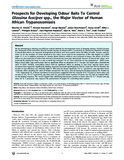| dc.contributor.author | Omolo, Maurice O. | |
| dc.contributor.author | Hassanali, Ahmed | |
| dc.contributor.author | Mpiana, Serge | |
| dc.contributor.author | Esterhuizen, Johan | |
| dc.contributor.author | Lindh, Jenny | |
| dc.contributor.author | Lehane, Mike J. | |
| dc.contributor.author | Solano, Philippe | |
| dc.contributor.author | Rayaisse, Jean Baptiste | |
| dc.contributor.author | Vale, Glyn A. | |
| dc.contributor.author | Torr, Steve J. | |
| dc.contributor.author | Tirados, Inaki | |
| dc.date.accessioned | 2021-07-09T12:39:44Z | |
| dc.date.available | 2021-07-09T12:39:44Z | |
| dc.date.issued | 2009-05-12 | |
| dc.identifier.uri | https://doi.org/10.1371/journal.pntd.0000435 | |
| dc.identifier.uri | https://journals.plos.org/plosntds/article?id=10.1371/journal.pntd.0000435 | |
| dc.identifier.uri | http://r-library.mmust.ac.ke/123456789/1775 | |
| dc.description.abstract | We are attempting to develop cost-effective control methods for the important vector of sleeping sickness, Glossina fuscipes spp. Responses of the tsetse flies Glossina fuscipes fuscipes (in Kenya) and G. f. quanzensis (in Democratic Republic of Congo) to natural host odours are reported. Arrangements of electric nets were used to assess the effect of cattle-, human- and pig-odour on (1) the numbers of tsetse attracted to the odour source and (2) the proportion of flies that landed on a black target (1×1 m). In addition responses to monitor lizard (Varanus niloticus) were assessed in Kenya. The effects of all four odours on the proportion of tsetse that entered a biconical trap were also determined. Sources of natural host odour were produced by placing live hosts in a tent or metal hut (volumes≈16 m3) from which the air was exhausted at ∼2000 L/min. Odours from cattle, pigs and humans had no significant effect on attraction of G. f. fuscipes but lizard odour doubled the catch (P<0.05). Similarly, mammalian odours had no significant effect on landing or trap entry whereas lizard odour increased these responses significantly: landing responses increased significantly by 22% for males and 10% for females; the increase in trap efficiency was relatively slight (5–10%) and not always significant. For G. f. quanzensis, only pig odour had a consistent effect, doubling the catch of females attracted to the source and increasing the landing response for females by ∼15%. Dispensing CO2 at doses equivalent to natural hosts suggested that the response of G. f. fuscipes to lizard odour was not due to CO2. For G. f. quanzensis, pig odour and CO2 attracted similar numbers of tsetse, but CO2 had no material effect on the landing response. The results suggest that identifying kairomones present in lizard odour for G. f. fuscipes and pig odour for G. f. quanzensis may improve the performance of targets for controlling these species | en_US |
| dc.language.iso | en | en_US |
| dc.publisher | plos neglected tropical diseases | en_US |
| dc.subject | Prospects, Developing, Odour, Baits , Control, Glossina, fuscipes, spp., Major, Vector, Human, African, Trypanosomiasis | en_US |
| dc.title | Prospects for Developing Odour Baits To Control Glossina fuscipes spp., the Major Vector of Human African Trypanosomiasis | en_US |
| dc.type | Article | en_US |

